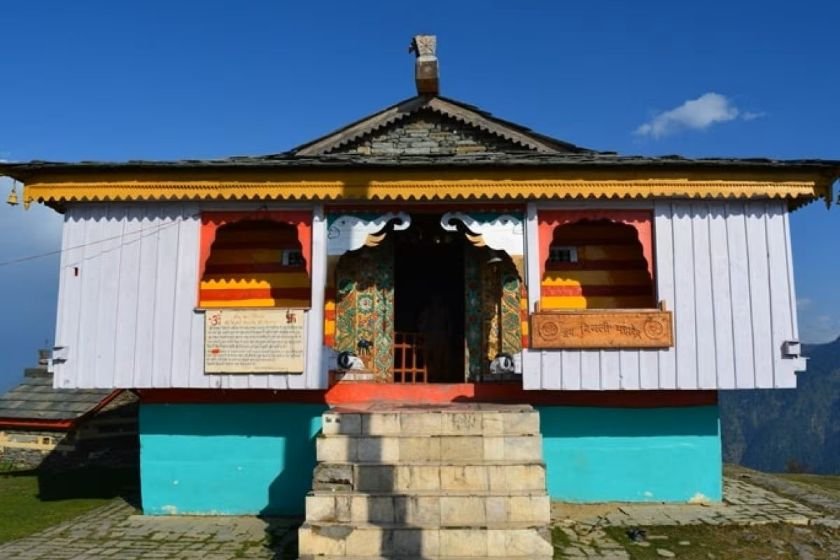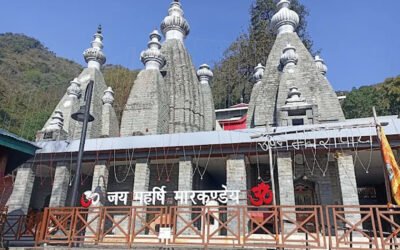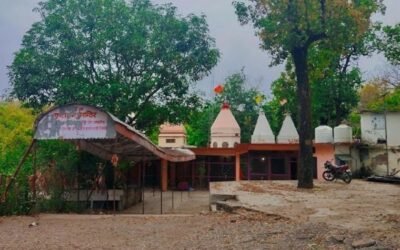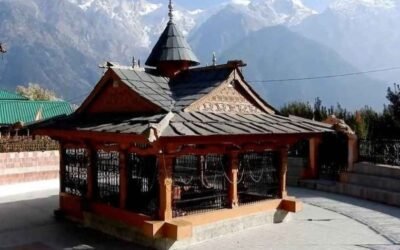Soaring above the confluence of the Beas and Parvati rivers, the Bijli Mahadev Temple stands at 2,460 meters on Mathan Hill in Kashawri village, offering panoramic views of the Kullu and Parvati valleys. But what truly sets this temple apart is its celestial connection—every few years, lightning strikes the Shiva lingam, shattering it into pieces, only to be ritually restored by the temple priest using a sacred paste of butter, flour, and cereal. This divine phenomenon gives the temple its name: Bijli (lightning) Mahadev.
🌄 Location & Accessibility
- Location: Kashawri village, near Kullu, Himachal Pradesh – 175138
- Altitude: 2,460 meters above sea level
- Nearest Town: Kullu (14–22 km, depending on route)
- How to Reach:
- By Road: Drive or take a taxi from Kullu to Chansari village
- Trek: A 3-km uphill trek (with ~1,000 steps) from Chansari to the temple
- Alternate Route: From Naggar via Jana Waterfall—a scenic 12-km forest trail
- By Air: Bhuntar Airport (~22 km from Kullu)
- By Rail: Joginder Nagar (~145 km) or Pathankot (~250 km)
🛕 Mythological Significance
Legend says that Lord Shiva destroyed the demon Kulanta, who threatened to flood the valley by taking the form of a giant serpent. To commemorate this divine act, the temple was built at the very spot where Shiva’s trident struck the earth. Another version links the temple to Shiva’s battle with Jalandhara, another asura defeated to save the valley.
The lightning strike is seen as a cosmic blessing, a divine recharge of the lingam’s energy. The 60-foot deodar staff outside the temple is believed to attract the lightning, channeling it into the sanctum.
🕉️ Deity & Worship
The temple is dedicated to Lord Shiva, venerated here as Bijli Mahadev—the lightning deity. A large lingam made of stone is installed in the sanctum, known for being shattered periodically by lightning, then ritually restored with sattoo (barley flour) and butter by the temple priest. Daily worship includes bilva leaves, raw milk, water, and incense offerings. Devotees climb the hill to seek absolution of sins and divine strength, especially during Mahashivratri and after lightning strikes.
🏛️ Architectural Highlights
- Built in Kath-Kuni style, using wood and stone—a hallmark of Himachali temple architecture
- The sanctum houses a Shiva lingam, surrounded by stone sculptures of Nandi and Shiva
- A wooden corridor allows devotees to circumambulate the sanctum
- The deodar staff, wrapped in metal, stands tall as a lightning conductor and spiritual beacon
🎉 Festivals & Rituals
- Mahashivratri: The most significant celebration, with night-long bhajans, abhisheks, and community feasts
- Annual Lightning Ritual: When the lingam is shattered by lightning, the priest reconstructs it using sacred paste—an act of faith and renewal
- Daily Aartis: Held at sunrise and sunset, accompanied by conch shells and temple bells
- Pilgrimage Season: April to June and September to November are ideal for darshan and trekking
🏞️ Nearby Attractions
- Naggar Castle & Roerich Art Gallery: A blend of history and art
- Jana Waterfall: A serene picnic spot en route to the temple
- Basheshwar Mahadev Temple, Bajaura: Another ancient Shiva shrine nearby
- Kasol & Manikaran: Spiritual and scenic escapes in the Parvati Valley
🙏 Spiritual Experience
The Bijli Mahadev Temple is not just a shrine—it’s a cosmic theatre, where lightning becomes a ritual, and destruction leads to renewal. As you stand before the lingam, knowing it has been shattered and reassembled by divine will, you feel the raw power of nature and the quiet strength of devotion converge.




